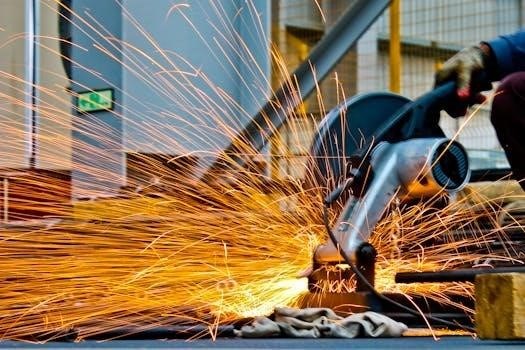Quickness of action is a vital aspect across various fields‚ from sports and martial arts to video games and film editing. This concept involves the ability to execute movements and reactions with speed‚ efficiency‚ and precision‚ often under pressure. It’s a multifaceted skill that combines physical dexterity and mental agility‚ requiring training‚ focus and understanding.
Defining Quickness in Action
Defining quickness in action involves understanding it as more than just speed. It is the ability to perform actions rapidly‚ but also with control‚ accuracy‚ and efficiency. This means it’s not just about moving fast‚ but about how quickly one can initiate‚ execute‚ and complete a specific task‚ be it a physical movement‚ a cognitive decision‚ or a technical skill. Quickness also incorporates reaction time‚ the swiftness with which an individual responds to a stimulus. It requires a combination of physical attributes like agility and dexterity‚ alongside mental aspects such as anticipation and decision-making speed. Furthermore‚ it is crucial to note the context within which quickness is demonstrated‚ as its definition can vary across domains like athletics‚ combat scenarios‚ or even digital environments. Ultimately‚ quickness in action is the sum of these factors‚ leading to effective and swift performance.
Core Components of Action Speed
Action speed is determined by a mix of factors‚ including reaction time‚ movement velocity‚ and the efficiency of technique. These elements interplay to define overall performance in dynamic situations.
Action Speed in Game Mechanics
In video games‚ action speed is frequently represented as a core stat that directly influences how quickly a character can perform various actions. This can include anything from the speed of attacks and spellcasting to the rate at which a character moves across the game world. The mechanics of action speed are often critical for player progression and success. A character with high action speed might execute attacks faster‚ allowing for more damage output per second or quicker defensive maneuvers. Action speed also plays a crucial role in game balance‚ as it is often a key factor in determining the power and effectiveness of different characters or builds. Furthermore‚ it affects the responsiveness of the game‚ making it feel more fluid and engaging. The total modifier to a character’s action speed is often visible on a character screen.
Impact on Character Actions
Action speed significantly dictates the flow and effectiveness of character actions in a variety of contexts. It governs how rapidly a character can execute moves‚ from basic attacks to complex skills. In combat‚ a character with enhanced action speed can chain attacks more fluidly‚ creating opportunities for higher damage output and overwhelming opponents. It also affects the speed of casting spells‚ throwing traps‚ using consumables‚ and even recovering from being stunned. Faster actions can make the difference between a successful maneuver and a missed opportunity. Moreover‚ the feel and responsiveness of a character are highly dependent on their action speed. Higher action speed contributes to a sense of agility and precision‚ while slower action speed can make a character feel cumbersome; Consequently‚ action speed is a crucial factor in determining a character’s overall playstyle and effectiveness.
Action Speed in Real-Life Scenarios
In real-life situations‚ action speed translates to the ability to react swiftly and effectively to changing circumstances. This is critical in sports‚ where athletes rely on quick reflexes and rapid movements to gain an advantage. In self-defense‚ the speed of one’s reaction can be the difference between safety and harm. In emergency situations‚ first responders need to act quickly and decisively to mitigate risks and ensure the well-being of others. Action speed is also important in everyday tasks‚ from navigating busy streets to responding to a sudden event. It reflects the efficiency and agility with which individuals can interact with their environment. Developing and maintaining action speed can enhance performance‚ safety‚ and overall adaptability to various real-world scenarios.
Speed‚ Surprise‚ and Violence of Action
The concept of “violence of action” emphasizes the unrestrained application of speed‚ strength‚ surprise‚ and aggression to dominate a situation. It’s a principle often associated with military and self-defense contexts‚ where decisive action is paramount. This approach underscores the importance of not only being fast‚ but also overwhelming one’s opponent with an immediate and forceful response. The element of surprise is essential‚ as it can disrupt an adversary’s ability to react effectively. A commitment to the “violence of action” philosophy implies that techniques are only effective when delivered with the utmost conviction and determination. This combination of speed‚ surprise‚ and overwhelming force can lead to a quick and decisive resolution‚ emphasizing the need for complete commitment in critical situations. It suggests total and utter dedication.
Techniques for Enhancing Action Speed
Improving action speed involves targeted training methods‚ including acceleration runs‚ specialized skill development‚ and techniques from various disciplines like martial arts‚ focusing on speed and precision to enhance performance.
Training Methods for Speed Improvement
Effective speed improvement requires a structured approach incorporating both primary and secondary training methods. Primary methods focus on developing fundamental movement skills‚ such as proper running mechanics and agility drills. Secondary methods involve specialized training‚ such as sprint resistance and assistance techniques‚ to enhance acceleration and top-end speed. These methods also include practicing specific skills under modified conditions to make them faster and more efficient. Consistent practice of mental math can also help‚ enhancing the ability to think and react quickly. Furthermore‚ strength and power training are crucial‚ especially exercises that involve fast‚ short movements. The key is to progressively challenge the body and mind to adapt and improve both physical and cognitive aspects of action speed. Regular training‚ combined with strategic rest‚ is essential for optimal results.
Acceleration and Pace Runs
Acceleration and pace runs are two distinct yet crucial training methods for enhancing speed. Acceleration runs emphasize a rapid increase to maximum speed over a short distance‚ focusing on quick bursts of power. This method usually involves three phases⁚ an initial acceleration‚ a period of racing at top speed‚ and a final deceleration phase. Conversely‚ pace runs involve maintaining a consistent high speed over a set distance‚ helping to build endurance and sustain peak performance. Both methods are vital for developing different aspects of speed‚ focusing either on fast starts or maintaining high velocities. Understanding the difference and incorporating both in your training regimen is essential for comprehensive speed development. The emphasis on control and technique during these runs is key to avoiding injury and maximizing speed gains.
Specialized Skill Development
Specialized skill development is crucial for enhancing action speed in specific contexts. This involves isolating and refining particular movements or techniques that contribute to overall quickness. Such development includes activities that focus on precision and speed in actions like dribbling‚ catching‚ passing‚ and throwing‚ which are all essential in sports. In addition‚ specialized training may include resistance methods to build strength‚ and assistance methods to improve speed. This focused approach allows athletes and individuals to optimize their performance by improving the speed and efficiency of necessary skills. It also emphasizes the importance of training the nervous system to respond faster‚ leading to quicker reactions and more fluid movements. By targeting specific skills‚ an individual can significantly improve overall action speed.
Techniques from Various Disciplines
Various disciplines offer unique techniques for enhancing action speed. Martial arts emphasize precise and rapid movements‚ often combining speed with power‚ while sports like basketball focus on agility and quick decision-making. The principles of fast cutting in film editing can be applied to real-life scenarios‚ encouraging rapid transitions and efficient information processing. Also‚ in competitive shooting‚ techniques focus on minimizing the time between shots while maintaining accuracy. The concept of ‘violence of action‚’ used in military contexts‚ highlights the importance of speed‚ surprise and aggression to achieve dominance. These diverse methods demonstrate that techniques for improving action speed are widely applicable and can be learned from different fields.
Martial Arts and Self-Defense


In martial arts and self-defense‚ quickness of action is paramount for both offensive and defensive maneuvers. Training often involves repetitive drills to enhance speed and reaction time. Uechi-ryu‚ for example‚ dedicates considerable time to practicing various self-defense techniques‚ with the goal of performing them swiftly and effectively. The ability to quickly execute blocks‚ strikes‚ and evasive actions can be the deciding factor in a confrontation. The concept of ‘violence of action’‚ which emphasizes speed‚ surprise‚ and aggression‚ is often integrated into martial arts training. Furthermore‚ the development of techniques should include speed with force‚ meaning the faster the movement‚ the higher the impact. Thus‚ martial arts and self-defense focus on a combination of speed‚ technique‚ and power.
Shooting and Weapon Handling
In the context of shooting and weapon handling‚ quickness of action is crucial for both competitive and tactical scenarios. The speed at which a shooter can draw‚ aim‚ and fire directly impacts their effectiveness. This involves not only the speed of the hands but also the ability to quickly acquire a target and make the necessary adjustments. Competitive shooters often prioritize training to improve their speed in various aspects of shooting‚ such as reloading and transitioning between targets. Doug Koenig‚ a champion pistol shooter‚ emphasizes the importance of pushing the speed to enhance performance. The handling speed also affects how quickly weapons are stowed‚ swapped‚ reloaded‚ and deployed. In essence‚ the ability to handle a weapon with speed and precision is a core component of proficiency in shooting.
Action Speed in Different Contexts

Action speed manifests differently across various fields‚ influencing how tasks are performed and perceived. From film editing to video games‚ the manipulation of speed creates distinct effects.

Action Speed in Film Editing
In film editing‚ action speed is manipulated to control the pace and impact of a scene. Fast cutting‚ characterized by numerous short shots‚ can create a sense of urgency‚ chaos‚ or energy. This technique is often used in action sequences or during dialogue to emphasize reactions and non-verbal cues. Slow-motion‚ conversely‚ draws attention to specific moments‚ heightening tension and allowing viewers to absorb critical details. The strategic use of these editing speeds dictates the emotional response of the audience‚ shaping their perception of the narrative. Editors carefully balance fast and slow-motion sequences to control the flow and impact of the story. The rhythmic interplay of these speeds creates an engaging and dynamic viewing experience.
Action Speed in Video Games
In video games‚ action speed is a crucial stat that dictates how quickly a character performs actions. This includes movement‚ attacks‚ casting spells‚ and using items. A higher action speed allows characters to execute actions more rapidly‚ leading to faster combat‚ quicker resource gathering‚ and improved overall gameplay. This stat can significantly impact the effectiveness of a character‚ altering their playstyle and strategic approach. Games often provide ways to increase or decrease action speed‚ through skills‚ items‚ or status effects. Managing and optimizing action speed is a key factor in mastering many video games‚ directly affecting the player’s ability to react and perform in various situations. It directly impacts both reaction times and the speed of in-game actions.
Conclusion
The pursuit of quickness of action is a continuous journey‚ requiring dedication and a multifaceted approach. From physical training to honing specific skills‚ enhancing action speed is achievable through consistent effort and focused practice. Whether it’s improving reaction time in real-life scenarios or optimizing performance in video games‚ the principles of speed‚ precision‚ and efficiency are universally applicable. Understanding the core components of action speed‚ utilizing effective training methods‚ and applying these concepts across various disciplines‚ can lead to significant improvements in overall performance. Ultimately‚ quickness of action is about maximizing potential and achieving desired outcomes with speed and effectiveness‚ a goal that benefits any endeavor.
